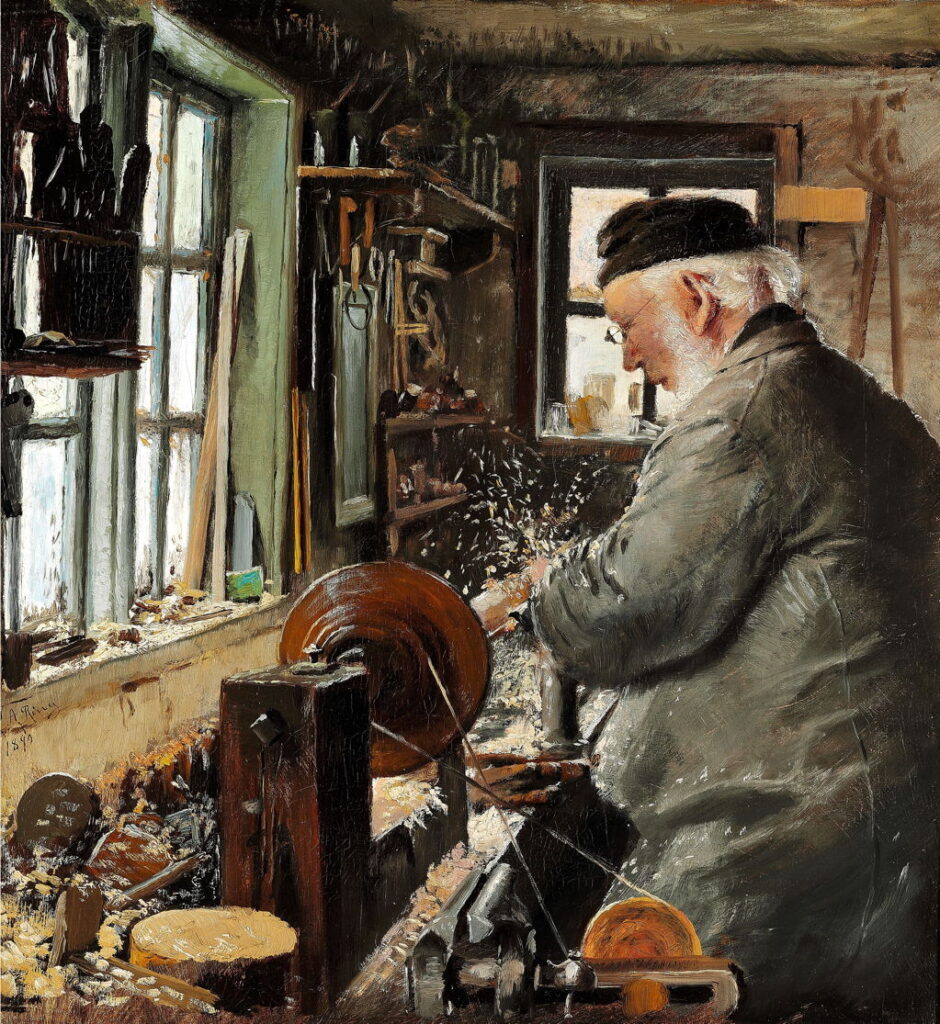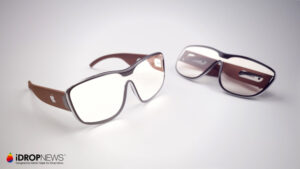Interiors by Design: Workshops

Workshops have long been a place of fascination, and make unconventional interiors. A great many painters have depicted their studios, but relatively few have gone behind the scenes to show what their staff and pupils were up to.
Jan Josef Horemans the Younger (1714–1792) In the Painter’s Workshop (before 1790), oil on canvas, 62 x 59 cm, location not known. Wikimedia Commons.
Horemans the Younger’s In the Painter’s Workshop (before 1790) puts the artist’s assistant in the centre, although he seems to be distracted by his family. On the left his master is working on a portrait of a young woman. In the assistant’s right hand is a muller on a stone slab to grind pigment with, and in the foreground a palette being prepared for use.
Some painters were also sculptors, and many had friends who carved and cast.
Thomas Eakins (1844–1916), William Rush Carving His Allegorical Figure of the Schuylkill River (1876-77), oil on canvas mounted on Masonite, 51.2 x 66.4 cm, Philadelphia Museum of Art, Philadelphia, PA. Wikimedia Commons.
William Rush Carving His Allegorical Figure of the Schuylkill River (1876-77) is the first of three paintings by Thomas Eakins showing William Rush, a wood sculptor, carving his Water Nymph and Bittern for a fountain in Philadelphia’s waterworks, in 1808. The water nymph is an allegory of the Schuylkill River, the city’s primary source of water at that time.
Rush had been a founder of the Pennsylvania Academy of the Fine Arts, and an enthusiast for the use of nude models in art, as was Eakins. This painting was therefore, at least in part, an attempt to promote Rush’s name, and the practice of working from nude models. Rush prepared thoroughly, as usual, in carving wax studies, and making a series of drawings and oil sketches.
Seated at the right of the model is a chaperone, more interested in her knitting. The model’s complicated clothing is hung and scattered in the light, as if to emphasise her total nudity (apart from a hair-band!), and the sculptor is working in the gloom at the left. Eakins anachronistically included several later works by Rush, as if to provide a resumé of his output. Unfortunately, the scattered garments didn’t go down well, and were deemed scandalous at the time.
Jean-Léon Gérôme (1824–1904), The End of the Pose (1886), oil on canvas, 48.3 x 40.6 cm, Private collection. Wikimedia Commons.
The End of the Pose (1886) is the first of Jean-Léon Gérôme’s series of unusual compound paintings, at the same time self-portraits of the artist as a sculptor, studies in the relationship between a model and their sculpted double, and forays into issues of what is seen, visual revelation, and truth. Here, while Gérôme cleans up, his model is seen covering up her sculpted double with sheets, as she remains naked. Apart from various diversionary entertainments, including a couple of stuffed birds and a model boat, there is a single red rose on the wooden platform on which the model and statue stand. Presumably this is a symbol of thanks from the artist to his model.
Jean-Léon Gérôme (1824–1904), The Artist’s Model (1895), oil on canvas, 50.8 x 39.6 cm, Dahesh Museum of Art, New York, NY. Wikimedia Commons.
In The Artist’s Model (1895), Gérôme paints himself at work on his marble figure Tanagra (1890), currently in the Musée d’Orsay, already included among the figurines in his painting Sculpturae Vitam Insufflat Pictura. He thus painted himself making a sculpture that he had previously painted in a painting as a sculpture. Not only that, but his model is his favourite Emma Dupont, who over a period of twenty years posed for many of his best-known Orientalist and other works.
Scattered in the image are reminders of gladiatorial armour and other props used for his paintings, one of his paintings of Pygmalion and Galatea, together with one of his polychrome sculptures of a woman with a hoop, at the right edge. In this single image, Gérôme has captured much of his professional career.
Lovis Corinth (1858–1925), Portrait of the Sculptor Nikolaus Friedrich (1912), oil on canvas, 101.7 × 81 cm, Private collection. Wikimedia Commons.
This wonderful Portrait of the Sculptor Nikolaus Friedrich (1912) at work wasn’t the first to be painted by Lovis Corinth, who had made a previous portrait in 1904, when the sculptor was young and muscular. Eight years later he’s seen in the midst of a broad and representative range of his work. Friedrich died two years later, when he was only 48.
During the latter half of the nineteenth century, painters started taking an interest in other craftsmen and women at work.
Ferdinand Hodler (1853–1918), Watchmakers’ Workshop in Madrid (1879), oil on canvas, 81 × 94 cm, Kunstmuseum Luzern, Lucerne, Switzerland. Wikimedia Commons.
Apparently after his return from Spain, Ferdinand Hodler painted this view of a Watchmakers’ Workshop in Madrid (1879), one of his first figurative works. The master watchmaker is seated in the centre, with an apprentice to the left, working in the bright light cast through the window in front of them.
Charles Frederic Ulrich (1858–1908), The Glass Blowers (1883), oil on canvas, 47.8 × 58.4 cm, Museo de Arte de Ponce, Ponce, Puerto Rico. Wikimedia Commons.
Charles Frederic Ulrich painted craftsmen in fine Naturalist detail. In The Glass Blowers (1883) the work is more delicate: blowing and preparing glass domes, perhaps for use as covers of watches and clocks.
Charles Frederic Ulrich (1858–1908), The Village Printing Shop, Haarlem (1884), oil on panel, 54 × 58.3 cm, Terra Museum of American Art, Chicago, IL. Wikimedia Commons.
Ulrich also painted a young apprentice drinking during a moment’s pause in his work in The Village Printing Shop, Haarlem (1884). At the left is a wooden type case containing type letters to be composed into a galley for printing in the large press on the right. This was in the days of painstaking manual typesetting.
Towards the end of the century, the Danish painter Laurits Andersen Ring painted several scenes of men at work.
Laurits Andersen Ring (1854–1933), A Turner at his Lathe (1890), oil on canvas, 40 × 36 cm, location not known. Wikimedia Commons.
Ring’s Turner at his Lathe from 1890 shows an unidentified craftsman turning a piece of wood on his treadle-powered lathe. Flakes of wood are flying in the air as he shapes what might become the leg of a chair. In each of these portraits, Ring is careful to show the humble surroundings in which these skilled workers exercised their craft: here a cramped and small workshop lacking in modern conveniences, and probably cold for much of the year.
Laurits Andersen Ring (1854–1933), Herman Kähler in his Workshop (1890), oil on canvas, 48.5 x 59 cm, Randers Kunstmuseum, Randers, Denmark. Image by Villy Fink Isaksen, via Wikimedia Commons.
Herman Kähler in his Workshop, painted that same year, shows the celebrated Danish ceramic designer and potter Herman A Kähler (1846-1917), who took over the family ceramic factory in Næstved, Sjælland (Zealand), in 1872. He’s now commemorated in the name of a rich ruby glaze, Kähler red. He had achieved considerable success at the Great Nordic Exhibition of 1888, and the following year at the Exposition Universelle in Paris. Both Ring and his friend Brendekilde designed work for his factory to produce.
Kähler is seen turning a pot by hand on a treadle-powered wheel. Carefully arranged around him are examples of his work in various stages of completion, including three that are finished and glazed.
Jean-Eugène Buland (1852–1926), The Tinker (1908), oil on canvas, 112.6 × 145 cm, Private collection. Wikimedia Commons.
Eugène Buland’s The Tinker (1908) is busy at his cottage industry, repairing damaged pots, pans, and domestic metal objects. He may still have gone out on the road to gather in pots and pans for repair, but was increasingly dependent on his workshop.
Robert Koehler (1850–1917), The Old Sewing Machine (date not known), oil on canvas, 100.3 × 75.6 cm, location not known. Wikimedia Commons.
As even modest households gained possession of mechanical devices such as sewing machines, their repair called for specialists. Robert Koehler’s undated The Old Sewing Machine shows a woman and her young daughter with a mechanic and repairman, looking at the woman’s old and very primitive sewing machine. They’re surrounded by the tools of the trade, including a bench vice and a small anvil. Behind and to the right is a small smithy.



